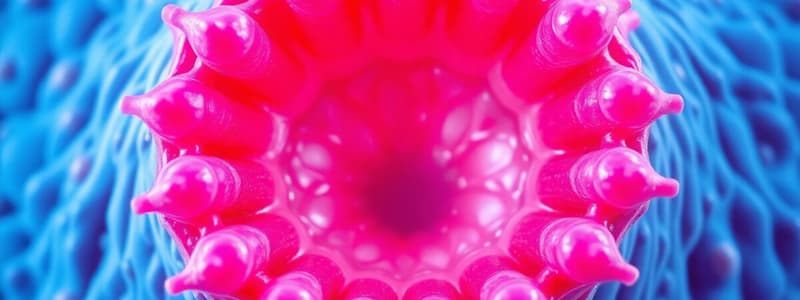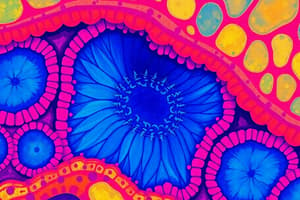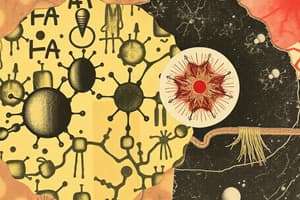Podcast
Questions and Answers
What is the primary function of microvilli in epithelial cells?
What is the primary function of microvilli in epithelial cells?
- Energizes cellular processes
- Prevents material flow between cells
- Increases surface area for absorption (correct)
- Facilitates cell movement
Which of the following proteins is associated with tight junctions?
Which of the following proteins is associated with tight junctions?
- Claudin and occludin (correct)
- Cadherins
- Desmogleins
- Integrins
What structural arrangement do cilia possess?
What structural arrangement do cilia possess?
- Continuous bands of cadherins
- Actin filaments in a web formation
- Microtubules in a 9 doublets+2 arrangement (correct)
- Half a desmosome structure
In which location would you primarily find hemidesmosomes?
In which location would you primarily find hemidesmosomes?
What is the main purpose of gap junctions?
What is the main purpose of gap junctions?
Which cellular junction serves to strengthen and stabilize nearby tight junctions?
Which cellular junction serves to strengthen and stabilize nearby tight junctions?
What type of arrangement do flagella share with cilia?
What type of arrangement do flagella share with cilia?
What is a significant medical consequence of defects in tight junctions?
What is a significant medical consequence of defects in tight junctions?
Flashcards
Microvilli
Microvilli
Tiny finger-like projections extending from the cell surface, increasing surface area for absorption.
Cilia
Cilia
Hair-like structures that beat rhythmically to move fluids or particles across the cell surface.
Flagella
Flagella
Long, single structures similar to cilia, responsible for cell movement.
Tight Junction
Tight Junction
Signup and view all the flashcards
Adherent Junction
Adherent Junction
Signup and view all the flashcards
Desmosome
Desmosome
Signup and view all the flashcards
Hemidesmosome
Hemidesmosome
Signup and view all the flashcards
Gap Junction
Gap Junction
Signup and view all the flashcards
Study Notes
Apical Cell Surface Specializations
-
Microvilli: Finger-like projections, stable and uniform.
-
Microvilli core: Actin filaments with actin-binding proteins.
-
Microvilli location: Small intestine and kidney tubules.
-
Microvilli function: Increase surface area for absorption (20-30 times).
-
Microvilli microscopy: Striations or brush border (light microscopy), detailed actin core (electron microscopy).
-
Cilia: Highly motile, longer than microvilli.
-
Cilia location: Upper respiratory tract and female genital tract.
-
Cilia microscopy: Hair-like structures (light microscopy), basal body and shaft (electron microscopy).
-
Cilia core: Microtubules (9 doublets+2 arrangement) with dynein arms for movement.
-
Cilia function: Move fluids or particles along the surface.
-
Flagella: Long, single, similar to cilia.
-
Flagella core: Similar to cilia's axoneme structure.
-
Flagella location: Sperm cells (form the tail).
-
Flagella function: Facilitate cell movement.
Cellular Junctions
-
Tight Junctions (Zonula Occludens):
-
Location: Apical position in epithelial cells.
-
Structure: Bands encircling cells; no intercellular space.
-
Proteins: Claudin and occludin.
-
Function: Prevent material flow between cells, form protective barrier (e.g., blood-brain barrier).
-
Medical Significance: Defects can affect the blood-brain barrier, leading to neurological disorders.
-
Adherent Junctions (Zonula Adherens):
-
Location: Below tight junctions, encircling cells.
-
Structure: Continuous band around cells connected to actin cytoskeleton.
-
Proteins: Cadherins.
-
Function: Strengthens and stabilizes tight junctions.
-
Desmosomes (Macula Adherens):
-
Location: Disk-shaped on adjacent cell surfaces.
-
Structure: Spot-like, binds intermediate filaments.
-
Proteins: Desmogleins, desmocollins (cadherin family).
-
Function: Maintain cell integrity and cohesion.
-
Medical significance: Autoimmune reactions can cause skin blistering.
-
Hemidesmosomes:
-
Location: Binds epithelial cells to basement membrane.
-
Structure: Half of a desmosome.
-
Proteins: Integrins.
-
Function: Anchors cells to the basement membrane
-
Gap Junctions (Nexuses):
-
Location: Throughout cell membranes.
-
Structure: Channels between adjacent cells, formed by connexins.
-
Function: Allow rapid exchange of small molecules for cell coordination and communication.
Studying That Suits You
Use AI to generate personalized quizzes and flashcards to suit your learning preferences.




